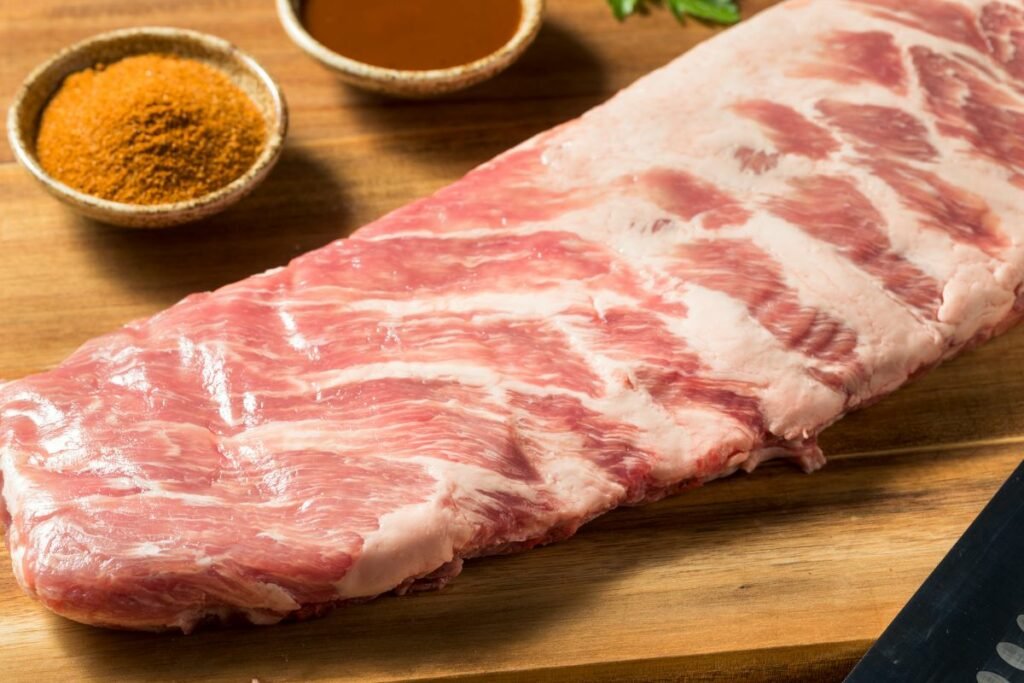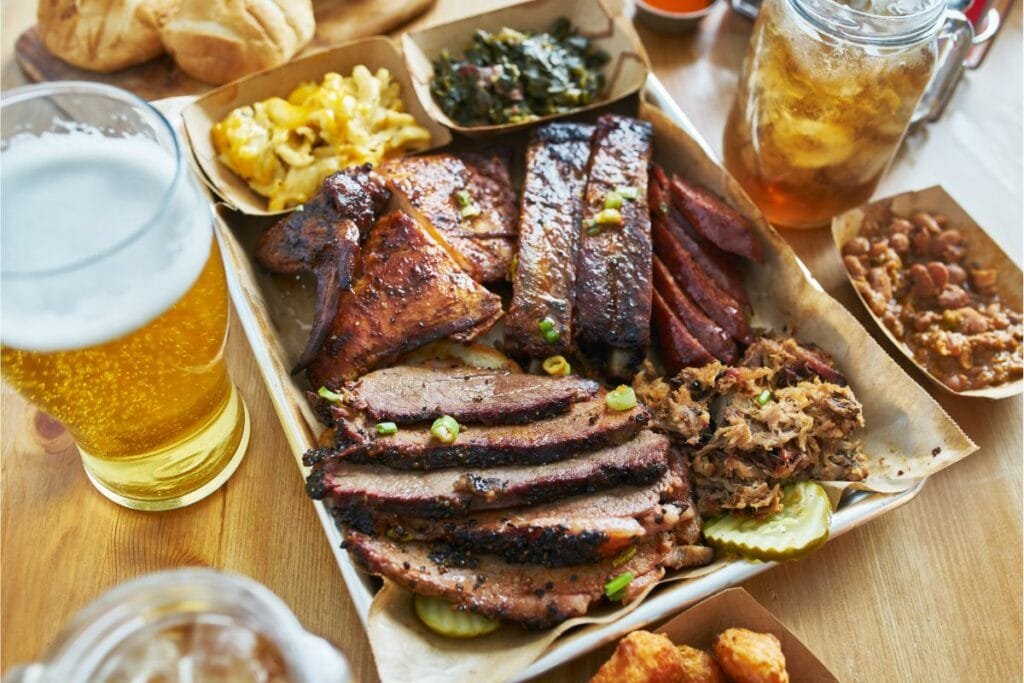St. Louis Ribs are often served with a side of coleslaw or potato salad. They originated from the American South and are traditionally cooked over hickory wood coals. The name comes from the shape of the rib bones, which resemble the letter S.
Baby backs are leaner and have a higher ratio of protein to fat. This makes them healthier options for those who want to eat fewer calories without sacrificing flavor.
St. Louis Ribs are known for their juicy meatiness, but they also tend to fall apart easily. Baby Back Ribs are much leaner and less fatty, but they don’t always cook evenly.
In this article, we will discuss which type of rib out of these two you should be serving up at your next barbecue.

Overview Of Pork Ribs
For a beginner, every pork rib looks the same, however to a professional, the differences between them are obvious and important. In this article, we will talk about baby back ribs and St Louis ribs.
However, before we get into detail about them, we thought it would be best to briefly discuss the other types of pork ribs.
There are in fact 4 types of ribs. These include:
- Spare Ribs,
- Rip Tip,
- St Louis Ribs,
- Baby Back Ribs.
The baby back ribs are found from the tip of the pig’s rib cage. Compared to the rib tips that consist mainly of cartilage and fat that hangs near the belly of the animal.
Both St Louis and spare ribs are essentially the same cut, and are found in the middle of the rib cage.
Normally, baby back ribs will contain meat that has been left behind when a butcher has removed the pork loins from the animal.
While spare ribs and St Louis ribs are the same thing, yet it is the fact that St Louis ribs have been trimmed. This then gives the ribs a more uniform look.
About Baby Back Ribs
A lot of people love to eat baby back ribs, but they aren’t made from the bones of baby pigs, as the name may suggest. Instead, the ribs are referred to as baby back ribs, due to their size, not the fact that they are from piglets.
However, the name is completely deceiving, these ribs are located in the upper part of the rib cage. This is the part of the rib cage that meets the spine.
Often a butcher will remove the baby back ribs after they have removed the loin first. This is also why baby back rib meat is very tender.
Sometimes, these ribs can also be referred to as back ribs or loin back ribs. Either way, these ribs are much smaller compared to spare ribs. This is why they were given the name ‘baby’.
When it comes to purchasing these ribs, they are often sold in packs of 10 to 13 ribs.
On a pig they have around 15 to 16 ribs, but this can vary depending on the breed of the pig. Then, as a butcher divides up the body, a few of these ribs can sometimes get left behind.
However, if you notice that a rack of ribs contains less than 10 ribs, this is referred to as a cheater rack.
On appearance, a set of baby back ribs are much wider on one side. They have long bones they will measure around 6 inches, with some shorter bones reaching 3 inches long.
These bones will be slightly curved, which can make cooking these ribs slightly difficult when over direct heat. This is the main reason that the cooking of baby back ribs uses indirect cooking methods such as smoking.
About St Louis Ribs
As we have mentioned above, St Louis ribs are just a set of spare ribs, which have been trimmed to give them a much more uniform look. The cartilage on the bones is often what is trimmed away.
These ribs come from the lower part of the rib cage, thus this means the meat has much more flavor but also more fat than baby back ribs.
You may also notice that the bones on St Louis ribs are much flatter, which helps the meat to brown a lot easier.
Why Is The Cartilage Removed?
Butchers will remove the cartilage on St Louis ribs, to make them look much more appealing and attractive to eat. This is why they have become a popular choice for pit masters.
Also, for beginners, it can be scary to deal with all the connective tissues that are found on spare ribs. Thus, it removes any extra work for any cook to remove that cartilage themselves.
Breakdown Between Baby Back And St Louis Ribs

Availability
Baby back ribs are an extremely popular choice of ribs. As a result, they are very easy to find in most meat sections of any store. They are also a common sight in many butcher shops, and you can place an order with them.
However, St Louis ribs aren’t as popular as baby back ribs. Even though they aren’t as popular, they are still quite easy to find. You may need to go to the meat counter of your store to find these.
Otherwise, go to your local butchers to place an order. You are bound to have more luck at your butchers than at your local store when trying to get your hands on St Louis ribs.
Price
The price of anything will be a huge factor of which types of ribs you will want to purchase. As baby back ribs are a popular choice, the price for these ribs is often higher than St Louis ribs.
Thus, if you are on a tight budget, St Louis is a more affordable option. However, if you buy regular spare ribs over St Louis ribs, you will save yourself even more money.
As the extra money is just on trimming the cartridge off.
Texture
Baby back ribs have a much leaner meat due to where it is located in the pig’s body. However, this means that the meat on these ribs can dry out quite quickly when they are grilled.
Compared with St Louis ribs that are cut from the stomach of the big. As a result, these ribs contain a lot more fat.
However, as long as these ribs are prepared properly then, the meat will still become tender and fall away from the bone easily.
Taste
As baby back ribs contain so little fat, they have little flavor to them, compared to spare ribs that have lots of fat. Hence, you will often see baby back ribs covered in a sauce when on a menu to give them more flavor.
With that being said, try to not over season your St Louis ribs. This is due to all the fat which melts during cooking that adds the flavor to these ribs. You can serve these ribs with a sauce on the side.
A lot of chefs like to let these ribs’ own flavor shine on their own. However, you can add a sauce over the ribs, but wait until the last 15 minutes of cooking time to do this.
Otherwise, the sugars in the sauce will burn and give your ribs a sore acidic flavor.
Weight
Generally, a portion of baby back ribs will weigh around 2 to 3 pounds. Although, half of the weight is just due to the bones. As they are so small, a full rack of these ribs will only serve two people.
St Louis ribs are similar in weight, as they can roughly 3 pounds with 10 to 13 bones. These bones are 6 inches long. The fat in these ribs is what makes them so heavy.
Preparation
Both baby back and St Louis ribs taste great when they are prepared the right way. We would suggest that if you have the time, you smoke these ribs, as the smoky flavor really enhances the flavor of the ribs.
Even grilling the ribs as a way of preparation will add some extra flavor that compliments the pork flavor.
You may want to prepare the ribs inside, in this case you need to do it long and slowly. You want to cook the meat for a long time at a low temperature, to let all the fat render down and to tenderize the meat as well.
However, if you are in a rush you can cook baby ribs quickly, and it doesn’t affect the taste or texture. If you want to brown the ribs before you cook them.
Be aware that due to the flat bones of St Louis bones, the majority of the ribs surface will come into contact with the heat and brown easily.
However, baby back ribs are slightly curved, which makes browning the meat evenly a lot more difficult.
Cooking Time
St Louis ribs take much more time to cook, as they are bigger ribs. Cooking these ribs at around 300 degrees Fahrenheit will take around 2 to 3 hours for the ribs to cook.
The same temperature for baby back ribs will take these ribs around 1 to 2 hours to cook.
However, you can set the temperature lower to cook both ribs at around 250 or 275 degrees Fahrenheit.
Although, the lower temperature will result in a longer cooking time. If you have the time, we would recommend that you cook the ribs as long and slowly as you can.
Serving Sizes
You need to think about how many people you are planning to feed when choosing a type of ribs. If there aren’t many people to feed, then the St Louis ribs are the way to go.
As they have a richer flavor and can be prepared in smaller batches in the oven or on the grill.
However, if you are planning on a large gathering, then we would suggest you choose baby back ribs. This is because you can cook more of these ribs at once. They are a great option for a starter or finger food.
Substituting Baby Ribs For St Louis Ribs
You can easily swap these two types of ribs for each other. However, you need to take these differences into consideration.
For example, if you decide to use baby back ribs instead of St Louis in a recipe that suggests them. Then you are going to need to almost double the amount of baby ribs to meet the amount that was needed of the St Louis ribs.
Yet, if you are using St Louis in replace of baby back ribs, then you need to reduce the recipe by almost half. If a recipe asks for 3 pounds of baby ribs, then you need only a maximum of 2 pounds of St Louis ribs.
Conclusion
Both baby back ribs and St Louis are delicious rib choices for a meal. Baby back ribs may be a better choice for those or have little experience or time cooking with ribs. This is because St Louis needs slightly more preparation and time to get them right.
Choosing between these sets of ribs can be difficult. Yet, it comes down to how much time you have and how many people you need to feed.
We would suggest that you try both sets of ribs to see which one is more suited to you and your tastes.
We hope you have found this article helpful, and have a better understanding of baby back and St Louis ribs.
